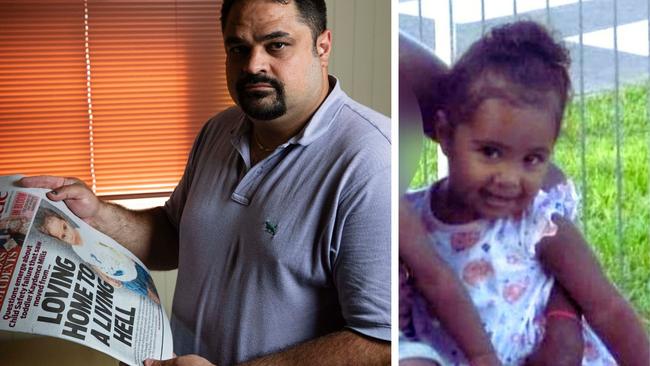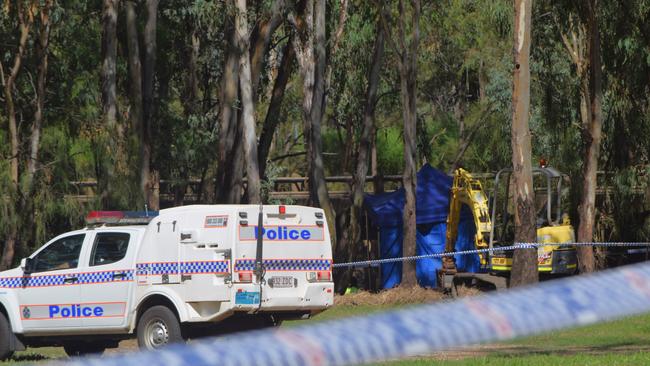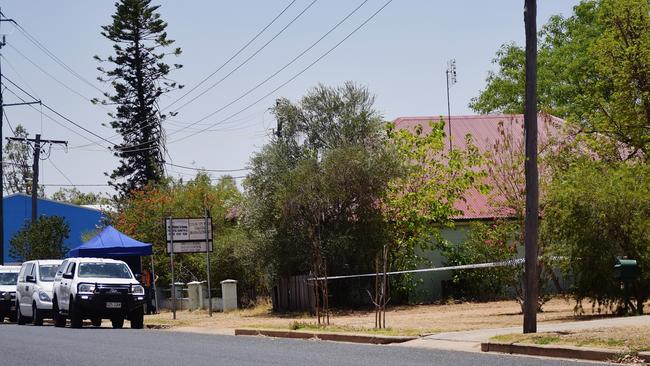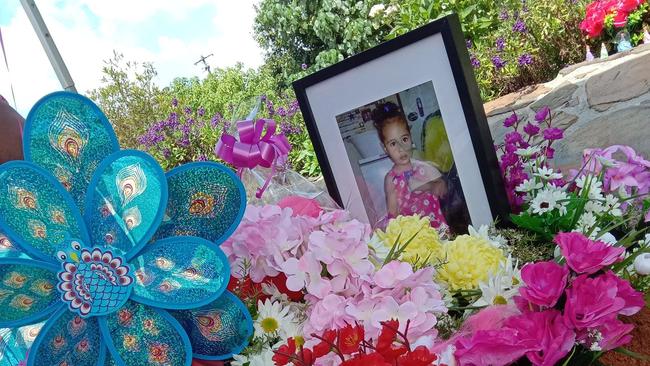Kaydence Mills: New details reveal system failings that may have helped prevent Chinchilla toddler’s death
An investigation into the Child Safety orders for Kaydence Mills has revealed the two-year-old should not have been in the care of her mother and the man who would horrifically murder her. Now a former worker is calling for changes to the “broken” system.

News
Don't miss out on the headlines from News. Followed categories will be added to My News.
Murdered toddler Kaydence Mills should never have been left in the unsupervised care of her mother and killer stepfather when she was neglected, beaten, and left to die on a couch, according to basic policies and procedures of the Department of Child Safety.
An investigation into the two-year-old’s Intervention Parental Agreement has revealed the two-year-old girl should have been receiving department visits.
Given her circumstances, the department should have regained custody of the child as her “risk level” exceeded the guidelines of an IPA.
Kaydence died in regional Queensland in early 2017, but was missing for more than two years before the Department of Child Safety became aware of abhorrent acts occurring in her Chinchilla home.
Raised in the system from birth, Kaydence had been living with her biological mother, Dawitta Sinita, for a handful of months before she was tortured, and ultimately killed by her stepfather Tane Desatge.
A judge found Ms Sinita not guilty of her daughter’s murder at trial.
A former child safety worker said if the “broken” system continued to “fester in a culture of failure and secrecy,” preventable deaths would continue to occur.
A spokeswoman for the Department of Child Safety echoed an earlier statement that the “person” responsible Kaydence’s “tragic, cruel, and abhorrent” death had been held accountable.
“It is significant that criminal proceedings have now been finalised and have held an individual accountable,” she said.
Child Safety should have visited Kaydence during torture period
During Desatge’s murder trial, Kaydence’s child safety officer testified that when she was given back to their mother in September 2016, she was subject to an Intervention Parental Agreement (IPA).
Child Safety implements an IPA if a risk assessment finds a child is in need of further protection once formal court orders have expired and run for a minimum of six months.
The former child safety officer, who had only been working for the department for a month before overseeing Kaydence’s case, said they “believed” the IPA ran for three months, ending the day she relocated from Far North Queensland to the Western Downs in December 2016.
“I had a fairly lengthy conversation with Mr Desatge on that particular day and it was in relation to the department’s hopes and wishes and expectations going forward and it was constructive,” they said during the trial.
Accredited social worker and former child safety officer Vishal Chandani told News Corp Australia if the child safety system functioned properly Kaydence may still be alive today.

Mr Chandani said if the IPA had not been closed after three months, the systems in place could have identified ongoing abuse and led to department intervention.
“You don’t close an IPA after three months,” he said.
When asked what the minimum time frame of an IPA order was, the Department of Child Safety spokeswoman declined to comment.
Kaydence shouldn’t have been in the care of her mother
In 2022, a year after Kaydence’s body was found wrapped in garbage bags at the Chinchilla Weir two hours west of Toowoomba, the Queensland Family and Child Commission conducted a systemic review into Intervention Parental Agreements.

The report said the average duration of an IPA was between nine and 12 months “with a minimum of six months, however “up to 12 months is generally an appropriate length of time in which to address the concerns while a child remains in the home”.
“The decision to end an intervention must be informed by a comprehensive risk assessment.”
The report stated a number of circumstances when an IPA isn’t sufficient protection to manage the risk to a child’s welfare therefore another court order should be sought to again remove a child.
Kaydence’s case met those circumstances as her file flagged her mother’s partner was a domestic violence perpetrator and she was relocating far away from family and support structures.
The CSO who had Kaydence’s case when she was reunified with her mother testified he worked extensively with Ms Dawita over a long period of time and she proved time again that she loved her child and was good at caring for her.
However he said he did not vet her ”on-again-off-again” partner, who had a history of violence against Ms Dawita, because he wasn’t sure of their relationship, and that he “briefly” met Desatge a handful of times.
“I was never truly confident of the (on-and-off) relationship,” he told the court.

When asked about his recommendation Kaydence should be placed in the care of her mother and stepfather, they specified it was into the care of her mother.
“At no time was there any indication that Kaydence (was) in any danger or fearful of the living conditions of which (she was) being placed,” he wrote in her file.
Without having Kaydence’s file, Mr Chandani said he could not unequivocally say the Department of Child Safety failed to properly assess her risk level, however her stepfather absolutely should have been thoroughly assessed.
“We know that statistically the most likely person to hurt or kill a child is a step parent particularly in cases of domestic violence where it’s not their biological child,” he said.
The Department of Child Safety spokeswoman said since Kaydence’s death the department “invested heavily in the Safe and Together model to help practitioners be domestic and family violence informed and to better hold perpetrators to account”.
She said in 2016, new CSOs were required to complete mandatory Domestic and Family Violence (DFV) training online and now new officers spend one day of face-to-face training on DFV.
“Face-to-face mandatory CSO training has been increased since 2023 and newly appointed CSOs receive direct learning support for their first year of employment through Senior Learning Advisor coaching,” she said.
A “witch-hunt” for frontline workers won’t fix the real problem
Mr Chandani said vulnerable children would continue to slip through the cracks of the broken Child Safety system as inexperienced and overworked Child Safety officers struggled with unsustainable caseloads, inadequate training, high staff turnover rates, and a lack of quality leadership.
“We need to look at the systems that are allowing these errors to occur because that is actually the problem, not these poor individuals that are inexperienced (and) overworked,” he said.

He said new recruits were thrown into the deep end with limited guidance, noting the department used to train new child safety officers over 12 weeks before it was dropped to three weeks and then two weeks.
“They can literally enter into the department with a three-year university degree, have no experience, receive two weeks of training which focuses on policy and procedure not practical skills on how to do the job … and then thrust into that position,” he said.
“You don’t have time to not give them a case load because there are children not being seen, there are kids that are not being case managed.
“This is the reality of high workload (and) high turnovers … corners that get cut.
“It’s just the reality of doing the job but you damn well learn from your mistakes.”

The Department of Child Safety spokeswoman would not confirm if new CSOs were still being trained over a two-week period.
“A comprehensive suite of ongoing training is provided, covering topics such as domestic and family violence, alcohol and other drug use, mental health, high risk infants, sexual abuse, working with young people, interviewing children and court processes,” she said.
“Actions taken to support CSOs include formal workload management guidelines and strategies which focus on manageable caseloads, and employing additional support and professional staff.
“Professional supervision and formal opportunities for collaborative assessment and planning are also provided through mechanisms such as Suspected Child Abuse and Neglect team meetings and practice panels.”
At trial, the court heard the CSO who had Kaydence’s case when she was reunited with her mother had joined the department about a month prior.
Accountability and transparency needed for meaningful change
Mistakes that lead to children dying within the child safety system are allowed to continue due to a culture of “failure and secrecy”, according to Mr Chandani.
“The reality is there’s lots of other children that have lost their lives in part because of the incompetence of failures by the department and they aren’t published to the media because it’s a secret,” he said.
“If you put 100 CSOs in a room I think very few of them would actually know about Kaydence and I know that because when we meet with CSOs most of them don’t even know who she is.

“It’s a secret society, there’s an in-built secrecy not just for people externally but even people internally.
“There’s no process for external supervision, there’s no way for (concerned child safety officers) to whistleblow.
“That’s just not the case in most other workplaces.
“Realistically the only time you ever find out about anything going wrong in child safety is when a child dies and parents are charged criminally and they don’t plead guilty.”
Calls for justice for Kaydence and her family
An inquiry should be launched into the failings of Kaydence’s case, Mr Chandani said, but noted peak bodies would not comment on the case until the inquiry concluded – if and when it occurred.
“So what, 15 years after she (Kaydence) passes away ‘maybe’ then government will comment? And by then we’ll have how many government changes? The minister probably won’t be there anymore, so who holds them accountable?” He said.
“And the question still stands, why such a strong response to Mason (Lee’s) death, where is the same level of response to Kaydence’s death?”

“Shouldn’t we honour the children that die in these circumstances by learning from what’s happened to them and then trying to prevent it from happening to another child?”
“A year after Mason Lee happened … I was literally sitting across from senior leaders in the department to say we’d learned from Mason and then the same things had happened to her.
“She isn’t the only one.”
He said children within the overburdened system would continue to suffer unless there was a major restructure and overhaul of the child safety system.
“Outcomes for kids in care are as bad as they have ever been,” he said.
“We have more kids coming into care every year.
“We have the overrepresentation of Aboriginal and Torres Strait Islander increasing despite having closing the gap objectives.
“What part of this system isn’t failing at the moment, what part system isn’t in crisis?”
More Coverage
Originally published as Kaydence Mills: New details reveal system failings that may have helped prevent Chinchilla toddler’s death




